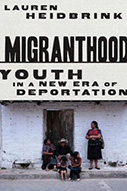Migranthood: Youth In A New Era Of Deportation

Author: Lauren Heidbrink
Publisher: Palo Alto, CA: Stanford University Press, 2020. 240p.
Reviewer: Leah Schmalzbauer | August 2021
As I was reading Migranthood, record numbers of child migrants were arriving at the southern border of the United States, the vast majority from Central America. I was immediately struck by how clearly Heidbrink’s analysis of migranthood – the complex political and social construction of migration – critically responded to the simplistic narratives presented in the media. Heidbrink’s theoretical framework has given me a much more nuanced lens to bring to the so-called “border crisis” and the media and political representations of it. Migranthood weaves together ethnography and policy analysis to explore why Guatemalan indigenous children are migrating, how they are experiencing the efforts to stem their migration, and how current security-based immigration policies are impacting their and their families’ lives. Beautifully and clearly written, this is a book of urgent theoretical and political importance.
Heidbrink’s transnational research draws on multiple methods. She uses in-depth interviews with deported children, as well as interviews with lawyers, social workers, migrant advocates, and Guatemalan public officials. Participant observation in Guatemala, including in centers housing deported youth, as well as in detention centers in the United States, contextualizes the interviews. She grounds her empirical work in rich historical data. The triangulation of these data sources provides an account of migranthood that centers children’s voices and family agency, while never losing the historical and policy framework that has contoured children’s experiences and choices.
While the focus of this book is on migrant youth, Heidbrink makes sure we never lose sight of the family and kin networks in which childhood is constructed and enacted. Indigenous Guatemalan children, albeit young in terms of their years lived, carry adult-like responsibilities. To be sure, they are important contributors to their families; their labor is often essential to family survival. Thus, we are forced to think about the ways social class, race and place shape the assumptions and moral judgements we have about childhood and what it should look like. The children in Heidbrink’s ethnography have had important responsibilities within their families long before venturing to the border.
The seriousness with which children take their responsibilities is a testament to the strong families of which they are part. Thus, though through a middle class lens the children may appear to be alone, or “unaccompanied,” this is far from how they are experiencing their migration. Instead, children say they feel the support of their families as they journey to the United States. They know that their parents are proud of them, and that their communities are proud of them. The love and support they have from their families inspires and motivates them to do what they know they need to do in order to contribute to collective survival. Children, above all, are agents in their own migration stories. They are caretakers, motivated by love of family, who find tremendous meaning in the responsibilities they carry. Their sense of kinship and embrace of strong family ties stay with them upon arrival and throughout life in the United States. They stay in touch via social media and display their loyalty through sending remittances which support family survival. Their place in the family collective is never lost.
To be sure, individualistic Capitalist ideologies of survival and mobility, which are hegemonic in the United States, clash with indigenous ideologies which center community well-being. To fully appreciate this ideological rupture, Heidbrink details Guatemala’s colonial legacy and how it has shaped patterns of migration within Guatemala and from Guatemala to the US. In post-colonial times, land reform policies which mandated individual claims made little sense to the Maya who had held their land collectively for centuries. When they failed to make claim to the land, they lost it, leaving them in a position of food vulnerability. What followed was migrations of Maya within Guatemala to work on export crop production. This labor-migration continues within Guatemala and also between Guatemala and Mexico. Indeed, youths’ migration to the United States is often not the first migration they have undertaken in search of wages. Colonial and post-colonial structures mandate migration as survival for many Maya people.
The poverty and marginalization produced by land seizures were exasperated by the Guatemalan Civil War, which devastated Maya communities. Heidbrink spares few details in explaining US complicity in the war, funding death squads, and supporting authoritarian regimes. Indigenous Guatemalans fared worst in terms of death and suffering. Though it was US intervention that generated the violence and insecurity at the root of their suffering, when Guatemalans fled for the United States, the vast majority were denied asylum. Thus, their lives on the margins continued in the United States, where they were forced into the status of living without documentation.
The US was not alone in denying refuge to Guatemalans who were fleeing for their lives. Heidbrink highlights a rarely talked about aspect of the War, in which indigenous Guatemalans sought refuge in southern Mexico. With US oversight, Mexico restricted Guatemalans to living in refugee camps with squalid conditions, and lack of resources. Refuge was nowhere to be found. And it continues to be nowhere to be found. Mexico continues to be a hostile, dangerous place for migrants.
Indeed, this colonial and post-colonial history continues to live in the present. Heidbrink makes clear the ways that centuries of policies favoring a landed elite have generated the current immigration crisis. She shows us the ways in which current policies of “securitized development” are an extension of policies which have long concentrated power and further marginalized indigenous Guatemalans. The discourse of “securitized development” frames migration from Central America as a security issue; it suggests that migrants threaten the sending and receiving countries. Securitized approaches to migration prescribe anti-corruption efforts, the strengthening of formal institutions in Guatemala, and development of alternatives to migration as the means to stem the flow. Heidbrink turns to the voices of youth migrants to reveal the naiveté and severe flaws that frame this logic. She compellingly argues that investment in policies that do not deal with the roots of migration are nothing short of a waste.
One of the policies that struck me as especially problematic was the public service announcement campaign, warning youths of the dangers of migration and encouraging them to aspire to the “Guatemalan Dream.” We learn from Heidbrink’s youth participants how flat these messages fall. The youths talk about how well they understand the dangers of undocumented migration. Heidbrink contextualizes these assertions by reminding the reader that most everyone in Guatemala knows someone one who has migrated, and many know someone who has died trying. Youths also talk with sophisticated cynicism about the notion of the Guatemalan Dream. While “the Dream” sounds nice, for the poor and working classes and especially for the indigenous poor, whose marginalization is compounded by racism, there exists no Dream. Until real opportunities are created that insure not only survival but mobility, and which allow youths to realistically aspire for a better life in Guatemala, youths will keep moving. They will move for their own survival and they will move for the wellbeing of their families.
And while they will migrate and many will never arrive, there are those who will arrive and will then have to return to Guatemala. Heidbrink’s analysis of the nuanced accounts of return marks another important contribution of this book. Here again, Heidbrink provides us with political context without losing the humanity of those who have to survive and live within this context.
The book ends with a short chapter focused on policy suggestions. This is the place in the book where I was left wanting more from Heidbrink. While she argues compellingly for the need to center children’s voices in policy discussions, I wanted to hear more about what this might look like. I think Heidbrink has the methodological and field experience, engaging in participant action in Guatemala and the United States, to think creatively about what this forum could look like, and who would be best equipped to carry it out. What would it take to bring members of Congress to Guatemala to engage in focus groups with youths? Or to simply listen to them speak, to share their experiences?
I hope Vice President Kamala Harris, who has been tasked with working in collaboration with leaders of the Northern Triangle –Guatemala, El Salvador and Honduras- to attend to the roots of migration, will read this book. Really, all policy makers who are focused on child migration should read it. Heidbrink’s research would inspire them to reflect deeply on the ways in which US policy has constructed this “crisis,” and it would help them clearly see the humanity which is at the center of it.
Leah Schmalzbauer, Professor of Sociology and American Studies, Amherst College


